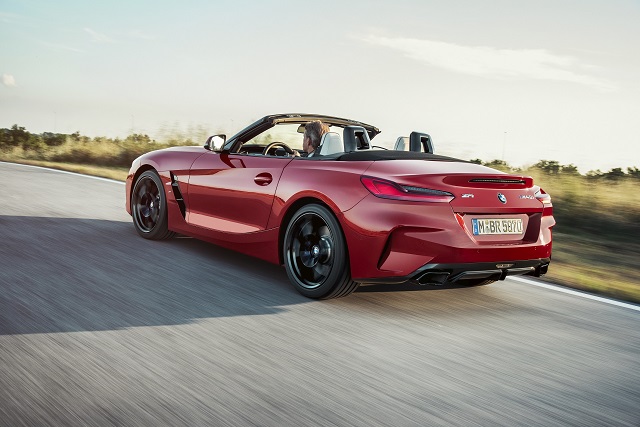Whether you’re after electric cars, sports cars or something out of left field, Tokyo’s got it.
The Tokyo Motor Show is one of the auto industry’s biennial auto shows, so don’t worry if you’re wondering how you missed the 2018 show — it didn’t exist. But it’s back for 2019, and like years past, there’s plenty of unique metal to take in.
Perhaps you’re interested in small cars that may or may not be electric. Perhaps your proclivities lie closer to the luxury segment. Or, heck, maybe you’re just ready to take in a bunch of wild concepts. No matter what you have in mind, there’s probably something in Tokyo with your name on it. Let’s take a look at what we expect to be there.
Honda Fit
Of all the cars debuting in Tokyo that have more than a snowball’s chance in hell of coming to the US, the next-generation Honda Fit is at the top of the list.
The Fit debuts in five different trims, and even packs a new, two-motor hybrid drivetrain. The styling has been reworked to make it a bit more bubbly than before, though this will likely lend itself to better overall outward visibility. A number of water-repellent, soft-touch materials are found inside, too. Here’s hoping this one comes to the US someday — though we aren’t holding out breath right now.

Lexus LF-30 Electrified concept
Lexus says the LF-30 Electrified concept embodies the vision that will define the brand’s future powertrains, driving feel and design. The “30” part of the name comes from the fact that 2019 is Lexus’ 30th anniversary.
The concept is powered by four electric motors making 536 peak horsepower. Things get wackier from there, with gullwing doors, a gesture-controlled glass roof, autonomous driving capabilities and, wait for it, drone-technology support that can do things like carry your luggage from the vehicle to your doorstep. You definitely don’t want to miss this one.

Nissan Ariya concept
You’d think a company like Nissan, which has great success with its electric Leaf hatchback, would jump at the idea to make an EV SUV. Well, that’s exactly what we have here, in the form of the new Ariya concept.
Unlike a lot of other forward-thinking concepts, the Ariya has real mirrors and appropriately sized wheels — both of which speak to its production-intent future. Copper accents link the styling to the mechanical bits found within, and ProPilot 2.0 tech allows for a higher level of driver-assistance features. This one might still be a few years off, but it’s definitely happening sooner rather than later.

Nissan IMk concept
Nissan’s group of IM-branded concept vehicles will expand once again in Tokyo with the introduction of the IMk electric concept, which was shown off before the show looking like a Nissan Cube for a new generation. It’s a tall-but-small upright concept that should offer a serious amount of interior space.
Nissan stayed light on details for its pre-show preview, so all we have is the one picture. We’re not quite sure how its electric powertrain is laid out, nor do we have any specific output or range figures, but Nissan will likely have far more information once the car makes its Toyko Motor Show debut this week.

Mazda MX-30
Called MX-30, the EV is a tall-hatchback-crossover-type thing, and uses rear-hinged suicide doors in place of conventional rear openings. Inside, the MX-30 has a large focus on sustainable materials — the seats are made of recycled bottles, and cork trim is used on the center console. An electric powertrain underpins the whole thing, though we don’t have any details on power output or electric driving range.
Look for the MX-30 to go on sale in Japan next year before slowly rolling out across the globe.

Mitsubishi Mi-Tech concept
Mitsubishi’s sharply styled concepts always bring a futuristic edge to auto shows, and its latest pair are no exception. The Mi-Tech hybrid concept almost looks like an electric dune buggy for two, with pronounced fender flares and an open roof to take in the surrounding air.
Rather than running on a gas engine, the Mi-Tech concept sports a unique plug-in hybrid powertrain with four electric motors, one on each wheel. But, instead of a usual combustion engine in there, the Mi-Tech’s PHEV powertrain includes a gas turbine, which will keep things nice and smooth.

Mitsubishi Super Height K-Wagon concept
In addition to the Mi-Tech, there’s another Mitsubishi concept making its debut in Tokyo. The Mitsubishi Super Height K-Wagon concept appears to have a pretty truthful name. It’s rather large box with some very tiny wheels at the extreme ends of the body. Promising some serious interior space, the “K-Wagon” part likely hints at the car’s diminutive footprint and powertrain. This is definitely a vehicle for Japan, by Japan.

Subaru Levorg
The second generation of Subaru’s weirdly named Levorg wagon makes its debut in prototype form in Tokyo. Unfortunately, this one won’t be coming to the US.
That said, look for the Levorg’s front end to appear on the upcoming, next-gen WRX sedan. There’s a new turbocharged engine under the hood, too, which might make its way across the Pacific to power some smaller Subaru vehicles. The Levorg gets updated EyeSight tech, too, which Subaru says allows for hands-off driving on Japanese freeways.

Subaru WRX STI EJ20 Final Edition
Subaru has used its 2.0-liter EJ20 flat-four turbo engine in some form for the last three decades, appearing first in the 1989 Subaru Legacy, and it’s finally time for that four-pot to ride off into the sunset. But, before that happens, STI has one more trick up its sleeve.
The Subaru WRX STI EJ20 Final Edition will exist as a farewell of sorts for the EJ20, as the name suggests. Coming with the aforementioned engine, 19-inch gold BBS wheels and unique badging, the car will apparently be allocated via lottery system, just like the Japan-only STI S208 from 2017.

Suzuki Hanare concept
Suzuki’s first of its two Tokyo concepts, the Hanare, apparently translates to “detached cottage,” and that seems spot on to define how this concept vehicle looks. This living room on wheels is all about autonomy, comfort and efficiency, although Suzuki hasn’t shown off any pictures of the interior just yet.
Its retro styling is mighty appealing, with some interesting use of sculpting in the main panels that wrap around the vehicle. Tiny windows up top help maintain privacy, while putting the wheels at the far end of the vehicle means there should be plenty of space inside.

Suzuki Waku Spo concept
Who doesn’t love a sports-car concept with retro styling? Bearing plenty of resemblance to the two-doors of yore, the Suzuki Waku Spo concept throws it back in terms of aesthetics while adding some newfangled tech into the mix.
This small A-segment coupe rocks a plug-in hybrid powertrain, although we’re not sure about output or any specific figures. Like many other concepts, the Waku Spo wears a set of cameras on the fender, acting in place of old-school fender mirrors. It’s a charming little thing, isn’t it?

Toyota Copen GR Sport
Concepts and EVs may take center stage in Tokyo, but there’s always room for something a little more traditional and a little more fun. Enter the Toyota Copen GR Sport.
Manufactured by Daihatsu, a Toyota subsidiary, this pint-sized two-seater features a retractable solid roof and a major focus on driving dynamics. Toyota Gazoo Racing engineers put in work here, increasing body rigidity, retuning the chassis and adding parts like a front brace and unique center support to ensure the Copen GR Sport can handle like no other.

Toyota LQ Concept
Toyota’s new-car onslaught in Tokyo isn’t just about production vehicles. The automaker will also debut the LQ concept, with the hope of getting it ready for public trials in 2020. Based on the Concept-i from 2017, the body has been given a few production-friendly tweaks, like usable door handles, slightly less wild wheel spats and a production-ready interior with a traditional steering wheel.
The LQ is a Level 4 autonomous vehicle, meaning it’s capable of operating without human oversight within specific locations or vehicle modes. Its headlights can project shapes onto the road to help passengers and pedestrians figure out what the vehicle intends to do next. When it’s time to let the robot do the driving, an embedded artificial intelligence called Yui can suggest the right music and keep the driver alert for when they need to retake control.

Toyota Ultra-Compact BEV
There’s small, and then there’s this. Ahead of the Tokyo Motor Show, Toyota showed off two pictures of its upcoming Ultra-Compact Battery-Electric Vehicle (BEV). The Ultra-Compact BEV is a proper city car meant for short-distance travel — we’re talking really short here, because the range is estimated at just 62 miles at a top speed of 37 miles per hour.
Destined for production (just not in the US), the Ultra-Compact BEV should offer up space for two people, with the driver positioned front and center while the passenger sits behind them. Small Japanese cars always have a whole lot of character to them, and this EV is no exception.

Toyota Yaris (Japanese spec)
In the US, the Toyota Yaris is currently based on the Mazda2. Australia, Europe and Japan will get a different 2020 Toyota Yaris, though — this one is a much more interestingly styled hatchback that’s new from the architecture on up.
Running on Toyota’s TNGA platform, which also underpins the latest Camry and Corolla, the new Yaris is lighter but stiffer. Multiple powertrains will be on offer, including a 1.5-liter three-cylinder gas engine, and a hybrid is in the works, too, with electric all-wheel drive. It’s also loaded with tech, including advanced driver-assistance systems, a head-up display and an automatic parking system. The front seats can also swivel slightly, which is novel.

Source: https://www.cnet.com/roadshow/news/2019-tokyo-motor-show-recap/
More on Cars






Leave A Comment
You must be logged in to post a comment.